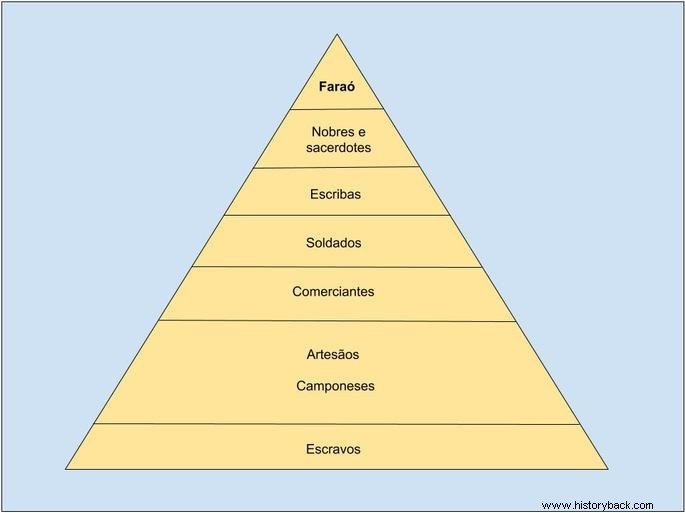The Ancient Egypt was one of the most important civilizations of antiquity.
Egyptian life was regulated by the floods of the Nile River. When the waters returned to the normal bed, they left the soil covered with a slime that fertilized the land for agriculture.
To better take advantage of it, the Egyptians developed systems of measurement and writing based on hieroglyphs.
As for religion, they were polytheists and in their pantheon they worshiped the god of the Sun, Ra and the god of the Living, Horus, among many others.
History of Ancient Egypt
Ancient Egypt was formed from the mixture of different peoples, the population was divided into several clans, which were organized in communities called nomos . These functioned as if they were small independent states.
Around 3500 BC, the nomes united to form two kingdoms:Lower Egypt to the north and Upper Egypt to the south. Later, in 3200 BC, the two kingdoms were unified by Menes, king of Upper Egypt, who became the first pharaoh, creating the first dynasty that gave rise to the Egyptian state.
It began a long period of splendor of Egyptian civilization, also known as the era of the great pharaohs.
Egyptian Society
Ancient Egyptian society was rigidly divided and there was virtually no social mobility.
At the top of society was the Pharaoh and his multitude of kin. The pharaoh was worshiped as a true god, as he was regarded as the intermediary between human beings and the other deities. Therefore, it was a theocratic monarchy, that is, a government based on religious ideas.
Below the pharaoh and his family came the privileged layers such as priests, nobles and officials. At the base of the Egyptian social pyramid were the underprivileged who were artisans, peasants, slaves and soldiers.
The priests formed, along with the nobles, the royal court. Both the nobility and the priesthood were hereditary, making up the military and landowner elite.
Scribes were at the service of the state to plan, supervise and control the economy. Therefore, they knew how to read and write and they were the ones who wrote down the pharaoh's deeds during his reign. These texts would be placed in their graves when they died.
The army, on the other hand, consisted of young people who were called up in wartime and foreign mercenary soldiers hired by the state.
For their part, artisans were salaried workers who performed different trades such as stonecutters, carpenters, jewelers, etc. Peasants formed the majority of the population, worked in agriculture, raising animals and had to pay high taxes.

In Egyptian society, women held a prestigious position. They could exercise any political, economic or social function on an equal footing with men of their social category. This even meant that they could be pharaohs, as was the case with Cleopatra.
Egyptian Civilization
The Egyptian civilization was extremely sophisticated and its marks are with us to this day.
The Egyptians, like all peoples of antiquity, were great astronomers and by observing the path of the sun they divided the calendar into 365 days and one day into 24 hours, which is still used by most western peoples today.
In medicine, the Egyptians wrote several treatises on remedies for curing diseases, surgeries and description of the functioning of the organs. There were also specialist doctors and their assistants, equivalent to current nurses.
In writing, Egyptian society developed writing by hieroglyphics. These were animal figures, body parts or everyday objects that were used to record history, religious texts, the economy of the kingdom, etc.
Egyptian Culture
The main art developed in Ancient Egypt was architecture. Deeply marked by religiosity, the constructions were mainly focused on the construction of great temples such as those of Karnac, Luxor, Abu-Simbel and the famous pyramids of Giza, which served as tombs for the pharaohs, among which Cheops, Khafra and Little men.
Egyptian painting was very peculiar, as it represented the body from the front, but the head was always in profile, in case the portrayed was standing. However, if he were seated, both the body and the head would be in profile. The walls of palaces, temples and especially the tombs destined for the pharaohs were painted.
The painting represented family scenes and the daily life of the kingdom, such as processions, birth and death, but also cultivation and harvest. Today, the paintings allow us to reconstruct the daily life of the Egyptians.
The large scale Egyptian sculpture depicted sphinxes, fantastic creatures, gods and pharaohs. It is worth mentioning the small-sized works such as the sarcophagi, made of stone or wood, in which the craftsmen sought to reproduce the features of the dead, to help the soul find the body. Some even had crystal pupils in their eyes.
See also :Egyptian Art
Egyptian economy
The Nile River was responsible for moving the economy, because after the floods, when the land was fertile, wheat, barley, fruits, vegetables, flax, papyrus and cotton were planted. Likewise, the Nile served for fishing and guaranteed political unity to ancient Egypt, because it was a way used to communicate the two points of the territory.
To better take advantage of the land yield, the Egyptians developed measurement and counting systems. After all, taxes were paid according to the size of the cultivated area and it was necessary to record the exact amounts charged.
The land belonged to the pharaoh and peasants were obliged to give part of their products to the state in exchange for the right to cultivate the soil. However, the construction of dikes, reservoirs and irrigation canals was the task of the State, which employed both free and slave labor to do so.
We have more text on this subject for you :
- Egyptian Civilization
- Egyptian Mythology
- Egyptian Gods
